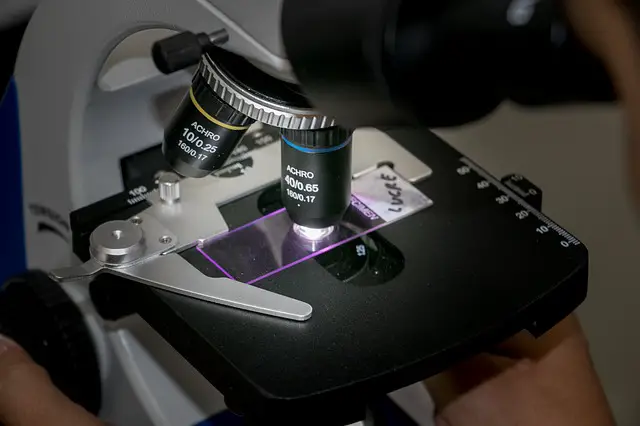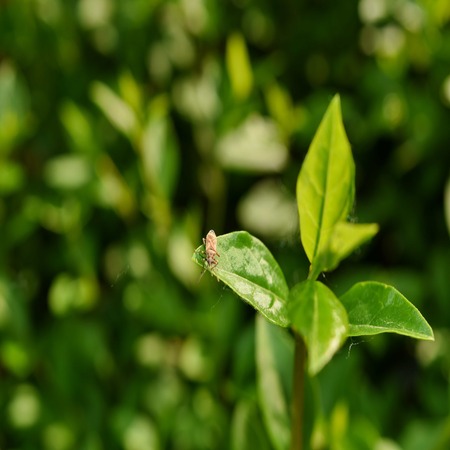Differences between Microbiology and Biochemistry
& Similarities
Introduction
Essentially, microbiology is the study of various microorganisms, their characteristics as well as their relationship with the surrounding environment. Organisms of interest in this field include fungi, bacteria, protozoa, viruses, and algae. Biochemistry, on the other hand, is the field of biology concerned with chemical processes in living organisms.
Here, biochemists focus their attention on various biomolecules within/or related to living organisms to determine how they are made, their functions, how they interact as well as their relationship with the organism. Here, some of the molecules of interest include proteins, DNA, carbohydrates, and lipids among others.
* Microbiology can be traced back to 1674 when Antony van Leeuwenhoek used a simple microscope to observe what he described as a vast population of minute living organisms.
Microbiology and Biochemistry
* According to Carl Woese, a Professor from the University of Illinois, microorganisms not only make up much of the biomass on earth but are also vital for the survival of human beings.
As mentioned, microbiology is the study of microscopic organisms. While a microbiologist is interested in learning more about the different types of organisms and their respective characteristics (general morphology, how they move, how they feed etc), they also focus on how these organisms interact with their environments and their relationship with others around them.
Today, there is an estimated 1030 microorganisms spread between 2 to 3 billion species. However, based on a number of more recent studies, the number of species may be as high as one (1) trillion given that many more microbes are yet to be identified.
Although biochemistry is not limited to microorganisms, it's related to microbiology in that it allows microbiologists and biochemists to understand the biological processes associated with these organisms as well as the production and functions of various biomolecules.
For instance, in order to differentiate between Gram-positive and Gram-negative bacteria, one has to analyze the peptidoglycan layer content (which is a polymer that consists of sugars and amino acids) on the cell wall of the organism and how it's produced. Here, it's possible to see how the two fields overlap.
Prokaryotes and Eukaryotes
With the exception of viruses, which are often referred to as particles (they are not really living organisms); microbiologists classify all microorganisms as either prokaryotes or eukaryotes. Prokaryotes include Archaea and bacteria species.
Being a group of organisms that proceeded eukaryotic organisms, prokaryotes are characterized by a simpler cell structure that consists of the DNA material, ribosome, and a cellular envelope. However, they may also possess a number of additional structures including flagella and cilia.
Generally, prokaryotes lack membrane-bound organelles which is one of their main defining characteristic. Eukaryotes (protists and fungi etc) are more evolved and are characterized by a more complex structure.
For instance, they have a nucleus (which consists of a nuclear membrane) as well as various membrane-bound organelles including the Golgi apparatus and mitochondria among others.
Microbiology
In microbiology, microscopy techniques can be employed to study and differentiate between prokaryotic and eukaryotic organisms. This made possible by comparing the morphological characteristics of the microorganisms under the microscope. For instance, as compared to eukaryotes, prokaryotes are generally smaller in size and contain a cell wall.
Based on these characteristics, it would be possible to distinguish between prokaryotes and eukaryotes without the need for further analysis. In addition, by using stains and given microscope techniques, it becomes possible to identify given structures and organelles of these organisms making it possible to identify the species. However, in some cases, biochemistry is not only required to identify the species under investigation, but also different strains of the species.
* Although viruses, like many other microscopic organisms are of importance in microbiology, it's worth noting that they are non-cellular, obligate parasites (intracellular parasites) that are commonly referred to as particles. As such, they cannot survive or produce without a host.
Biochemistry
To better understand the fundamental differences between prokaryotes and eukaryotes, then biochemistry is necessary.
Compared to eukaryotes, most prokaryotes have a cell wall and a capsule. Moreover, DNA material of prokaryotes is not enclosed within a nuclear membrane as is the case with eukaryotic cells. When studying the processes involved in protein synthesis between the two types of cells, it becomes evident that there are several important differences.
Given that prokaryotes lack a membrane-bound nucleus, both transcription, and translation occur in the cytoplasm at the same time. However, in eukaryotes where the DNA is enclosed in a membrane, transcription first occurs within the nucleus followed by translation in the cytoplasm.
As well, biochemistry makes it possible for researchers to understand how the cell membrane and capsule are formed in prokaryotes and how these components contribute to pathogenicity in the host (e.g. their involvement in adhesion to the host cell, etc).
Biochemistry allows researchers to understand various fundamental differences between prokaryotes and eukaryotes at the molecular level, so it can also be viewed as a vital field not only in biology but also in microbiology.
Ecology
Ecology is the area of study that is focused on the interactions between organisms and their surroundings. This is particularly important in microbiology given that for some of these organisms, especially the parasitic ones, their habitat plays an important role in how they are transmitted to the host. For instance, waterborne bacteria cause an infection when the host drinks contaminated water.
Some of the main microbial habitats include:
- Soils
- Freshwater habitats - river, streams, lakes, ponds, etc
- Oceans
- Rocks
Due to significant diversity, microscopic organisms are virtually omnipresent on the plant. As such, they can be found in almost all environments including some of the most extreme habitats (the Arctic, acidic lakes, and hydrothermal vents, etc).
In every environment in which microorganisms are found, they have been shown to play an important role in regulating biogeochemical systems. Based on their biomass alone, the microbial population has been shown to be one of the most significant carbon sinks.
According to a report that was published at the Woods Hole Oceanographic Institution, about 19 percent more carbon dioxide (than previously thought) is naturally removed from the atmosphere and stored in the seafloor trenches near island arcs.
Here, microorganisms that live in these habitats play an important role in storing carbon. On land, this is achieved through such processes as carbon fixing. Different microorganisms are also involved in a range of other processes including sulfur metabolism and methane metabolism etc.
In their habitats, microorganisms may exist as free-living organisms or as parasites. However, some of these organisms can live freely (feeding on organic matter or prey in their surrounding) and only result in parasitism under certain conditions.
In addition to other systems of classification, habitat and mode of nutrition are some of the aspects used to classify microorganisms in microbiology.
Marine microscopic organisms include various bacteria, algae, and protists found in marine habitats. However, these organisms can be further divided based on where exactly they are found in marine environments. Whereas some are found at the surface or near the surface of marine water, others reside at the benthic zone (e.g. benthic bacteria).
Apart from microorganisms found in different environments across planet earth, therein increasing interest to research the possibility of microbes in space and other planets. With space missions on the increase, researchers have also found it necessary to not only study the behavior of microorganisms found on earth in outer space, but also the possibility of finding other life forms, particularly microbes, on other planets.
In microbiology, microbial ecology not only makes it possible to determine where certain organisms live, but also some of the characteristics that make these habitats ideal for them. As a result, it has become possible to understand adaptations of various organisms to their environment as well as their role in these environments.
Ecological Biochemistry
With regards to ecology, biochemistry allows biochemists to understand the relationship of various organisms with their surroundings. In microbiology, ecological biochemistry provides valuable information regarding microorganisms in their surroundings.
Here, however, it's worth noting that in general, ecological biochemistry is concerned with the interaction between all living organisms (plants, animals various microbes) and the environment. For instance, biochemistry allows researchers to understand such essential processes like photosynthesis, adaptation of organisms to their environment (e.g. how Chemolithotrophs use inorganic compounds in order to survive in hydrothermal vents) as well as how certain organisms interact (e.g. in symbiosis) in order to survive etc.
Biochemistry is largely concerned with chemical processes within the cell so it has also made it possible to not only understand the mechanism involved in the production of various metabolites (e.g. phenolics and essential oils, etc) but also how various substances (toxins and chemicals, etc) in the environment impact the life of organisms. For example, Pesticides, used to control various pests, function by targeting and interfering with the normal activities of the nerve.
Nutrition
Nutrition is the field of study that is concerned with nutrients and food-related substances associated with maintenance, growth, health, and disease, etc. In microbiology, nutrition is often associated with ecology as most organisms obtain their nutrients from their surroundings. For this reason, these organisms are also classified based on food/source of energy.
Generally, microorganisms are classified as either autotrophs (capable of producing their own food) or heterotrophs (organisms that cannot produce their own food and thus depend on food sources in their surroundings).
In addition to the two general categories, microorganisms can be further divided into several more groups specifically based on how they obtain their energy, these include:
Photoautotrophs - In microbiology, photoautotrophs include such organisms as algae and cyanobacteria that use light energy to make their own food. Here, light energy is necessary to convert water, carbon dioxide, and other minerals into organic compounds.
Chemoautotrophs - Unlike phototrophs/photoautotroph, chemoautotrophs (e.g. iron-oxidizing bacteria and nitrogen-fixing bacteria etc) use inorganic compounds (hydrogen sulfide, ammonia, hydrogen, etc) as a source of energy. Here, the energy obtained from these compounds is used to fix carbon dioxide.
Photoheterotrophs and chemoautotrophs - Examples of photoheterotrophs include purple non-sulfur bacteria. While these organisms use light as an energy source, various organic compounds (e.g. fatty acids, carbohydrates and alcohols, etc) are required as carbon sources.
Unlike photoheterotrophs, chemoheterotrophs (e.g. some protozoa) obtain energy through the oxidation of chemicals (organic or inorganic compounds). However, they still require organic compounds as a source of carbon.
Saprophytes - Includes bacteria and fungi that feed on dead organic material in their surroundings. These organisms are also known as saprobionts.
Holozoic - Includes such organisms as amoeba and survive by ingesting (internalization) of food material, liquids or other prey.
Parasites - Includes some bacteria and protists that depend on other organisms (hosts) for food. Parasites can be found living within the cells (intracellular parasites), outside the cell (extracellular parasites) or on the surface of the host (ectoparasites).
Nutritional Biochemistry
In microbiology, nutrition and modes of nutrition are particularly important in that they allow scientists to classify various microorganisms to given modes of nutrition in their surroundings. In addition, it allows microbiologists to determine the impacts of these organisms on their ecology based on their mode of nutrition (e.g. carbon sink microbes), etc.
Nutritional biochemistry, on the other hand, not only considers the nutritional requirements for given organisms but also the significance and function at the cellular and molecular level. This has resulted in the discovery and better understanding of the mechanisms associated with nutrition-related processes.
Krebs Cycle
Krebs Cycle is an excellent example that highlights the molecules, processes, and products of chemical reactions in aerobic organisms. Following glycolysis, where sugar is broken down to produce 2 molecules of pyruvate (pyruvate is a 3 carbon molecule), the second phase of cellular respiration known as Krebs Cycle (citric acid cycle) starts in the presence of oxygen. However, before the cycle actually starts, pyruvate loses a carbon and combines with coenzyme A to produce acetyl-CoA (a two-carbon molecule).
The carbon released by the pyruvate then combines with oxygen to produce carbon dioxide, a waste product. The Acetyl-CoA produced here is a high energy molecule that enters the mitochondria in eukaryotic cells where it combines with oxaloacetate (a four-carbon molecule) resulting in the production of citric acid, a six-carbon molecule.
The acid then goes through a series of reactions, characterized by electron transport and oxidative phosphorylation, releasing energy that is stored in the form of NADH, ATP, and FADH2.
Looking at the example given in this section, it's possible to identify some of the molecules involved in the process, the type of process, its functions as well as the resulting products. Similarly, biochemists have studied and been able to explain many other processes not only in microorganisms but also in plants and animals.
Here, biochemistry not only allows researchers to understand how this works but also be in a position to manipulate them for different purposes. By understanding metabolic processes in given parasitic microbes, researchers can interfere with a given stage of the process and thus stop their proliferation in the body of the host.
While microbiology touches on these aspects of microbes, biochemistry delves deeper to explain all aspects of these processes for various biological purposes (e.g. treatment, drug development, etc).
* Apart from the examples given above, the differences between microbiology and biochemistry can also be identified in a number of other processes involved in reproduction and cell communication etc.
Similarities between Microbiology and Biochemistry
As explained, microbiology and biochemistry have several differences in that microbiology is concerned with the characteristics of microscopic organisms while biochemistry is concerned with biochemical processes and reactions in all living organisms. However, there are also several similarities between the two.
These include:
Living organisms - Both microbiology and biochemistry are centered on living organisms. In microbiology, researchers largely focus on microorganisms and their characteristics. However, microbiologists also study the interaction between these organisms and other organisms (plants and animals) in nature.
Biochemistry, on the other hand, is concerned with the biochemical processes with all living organisms. Here, then, one of the similarities is that they are both centered on living organisms.
Overlap - Despite the differences between microbiology and biochemistry, biochemistry allows researchers to better understand the characteristics of microscopic organisms. In biochemistry, biochemists can study the macromolecules that make up the surface antigens located on the surface of various microorganisms, etc.
As a result, it becomes possible to understand how these antigens bind to antibodies located on the surface of host cells.
Here, then, biochemistry can be said to be particularly important in that it allows students to better understand different characteristics of microorganisms.
* In some cases, studying the characteristics of microorganisms involves studying the biochemical processes involved. For microbiologists to understand the adaptations of a given parasite, they would have learned about the biochemical processes involved.
For this reason, there have been cases where biochemistry has been regarded as a sub-discipline of microbiology.
Check out:
Return from Differences between Microbiology and Biochemistry to MicroscopeMaster home
References
Forsythe S.J., Hayes P.R. (2000) Fundamental principles of microbiology. In: Food Hygiene, Microbiology and HACCP.
Jeffrey C Pommerville. (2012). Fundamentals of Microbiology.
Nicolai S Panikov. (2010). Microbial Ecology.
Pawan Kumar Bharti. (2014). Microbial Ecology and Habitat.
Tandra Mohanta, Deblina Dutta and Sudha Goel. (2017). Fundamentals of Microbiology.
Links
https://www.sciencedirect.com/book/9780121348366/nutritional-biochemistry#book-description
Find out how to advertise on MicroscopeMaster!







